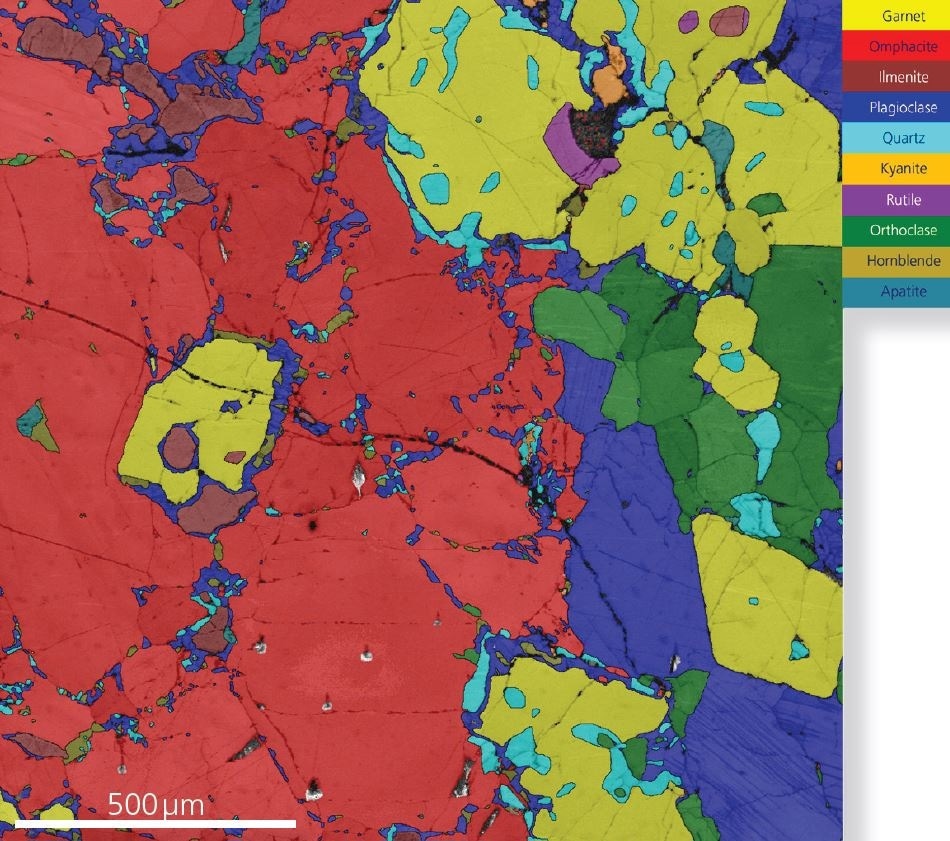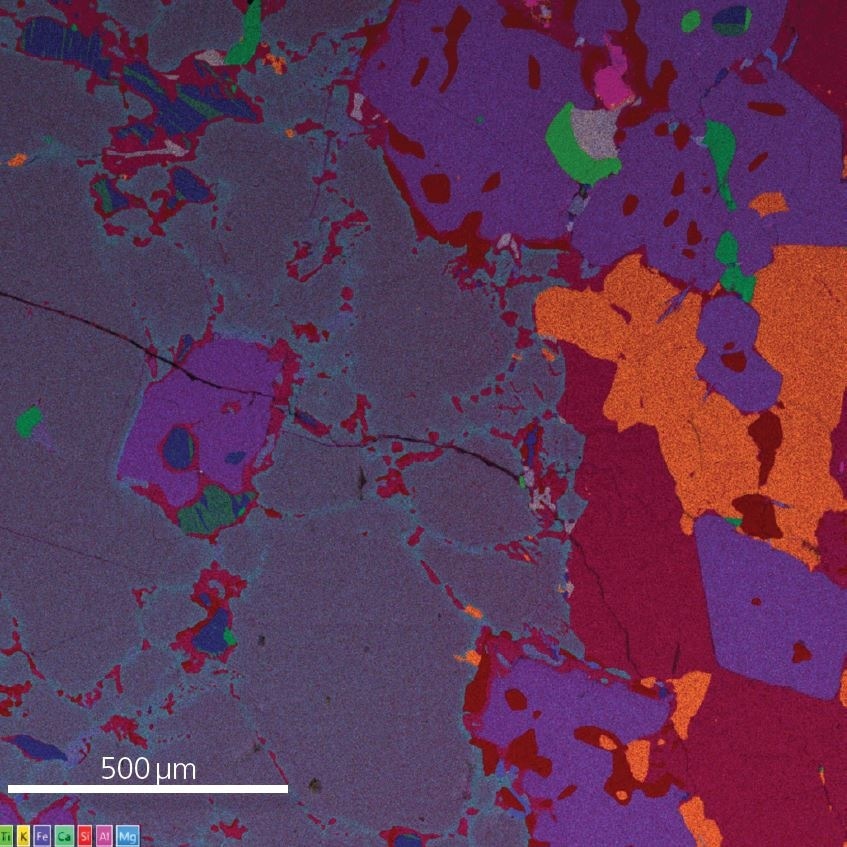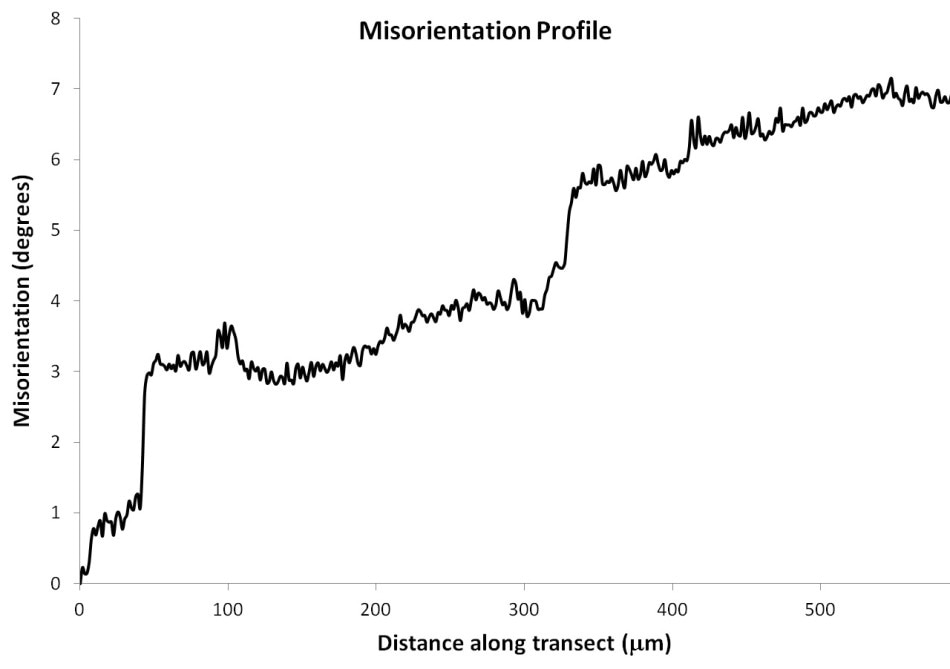Geological samples are very difficult to analyze using EBSD, because they are not only non-conductive, but also many rocks contain numerous phases, typically with low symmetry and often producing relatively weak diffraction patterns. There is a twofold challenge when it comes to analyzing the samples using EBSD. First, the EBSD detector should be sensitive enough to obtain high resolution EBSPs in a short period of time, and second the software should be able to distinguish reliably between all the minerals present in the sample.
This article shows the power of the Symmetry® CMOS-based detector together with the AZtec® software for successfully analyzing a multiphase, eclogite sample. Symmetry’s extreme sensitivity allows high quality diffraction patterns to be obtained in just a few milliseconds, and the advanced indexing algorithms within AZtec and the full integration of EDS data ensure accurate and reliable measurement of all phases.
Sample and Experimental Details
The sample is a high pressure rock sample, an eclogite, collected from the South Island of New Zealand. The mineralogy of the sample is relatively complex, with at least 10 phases present including omphacite, plagioclase feldspar, K-feldspar, quartz and garnet. Ilmenite, hornblende, rutile, kyanite and apatite are additional accessory phases. These phases represent a broad range of crystallographic symmetries, covering 6 of the 7 potential crystal systems.
Using 50 nm colloidal silica suspension, the sample was polished down to a final stage and was then coated with ~5 nm carbon prior to analysis to prevent charging. A field emission gun SEM was used for the EBSD analysis, using a 15 nA current at an accelerating voltage of 20 kV, scanning a 1000 x 1000 pixel grid on the surface of the sample with a 1.5 µm measurement step size.
The Symmetry detector was used to collect EBSD patterns at a 312 x 256 pixel resolution and with a 4 ms exposure time. An X-Max® 80 EDS detector was used for simultaneous collection of X-ray measurements, and AZtec was used to obtain data for all 10 phases. X-ray results supported the discrimination between the two feldspar phases, using the TruPhase option within AZtec. The hit rate was 96% at a speed of 247 indexed patterns per second, and minor data cleaning was carried out to remove isolated non-indexed and misindexed pixels. The full data were collected within 1 hour and 7 minutes.
Results
As shown in the phase map in Figure 1, the area is dominated by garnet and omphacite, with many small inclusions of accessory minerals and quartz. The two feldspars cover a large part to the right of the region, with plagioclase also forming small grains in the omphacite area. These were lying along channels with higher Mg and Ca levels, as indicated in the X-ray map in Figure 2..

Figure 1. Phase map, superimposed on a pattern quality map.

Figure 2. Mixed element X-ray map.
As illustrated in Figure 3a, the orientation map shows the coarse grained nature of the major phases, but does not provide much evidence for any preferred orientation. Twinning is observed within the quartz and the plagioclase feldspar grains, and evidence for plastic deformation in the omphacite grains is revealed by the transect in Figure 3b. There is over 7° change in orientation within a single omphacite grain: the high angular accuracy of this dataset allows very small orientation changes (<0.5°) to be picked out reliably.

Figure 3a. Orientation map (all Euler colouring scheme), superimposed on a pattern quality map. Red lines mark twin boundaries in the plagioclase and quartz. Thick red line marks a misorientation profile shown right.

Figure 3b. Relative misorientation profile along the transect shown in (a) within an omphacite grain.

Map showing the deformation within omphacite grains using the Grain Relative Orientation Distribution map component, superimposed on a pattern quality map.
Conclusion
With its balance of sensitivity and speed, the Symmetry detector is ideal for analyzing complex geological samples. In this case, an area of an eclogite sample has been successfully examined in just over 1 hour, with excellent measurement of all 10 phases, and simultaneous characterization of the chemistry through EDS. These results allow Scientists to fully understand the structural and metamorphic evolution of the suite of rocks from which the sample was collected.
Acknowledgments
Dr. Sandra Piazolo is thanked for providing the eclogite sample.

This information has been sourced, reviewed and adapted from materials provided by Oxford Instruments NanoAnalysis.
For more information on this source, please visit Oxford Instruments NanoAnalysis.